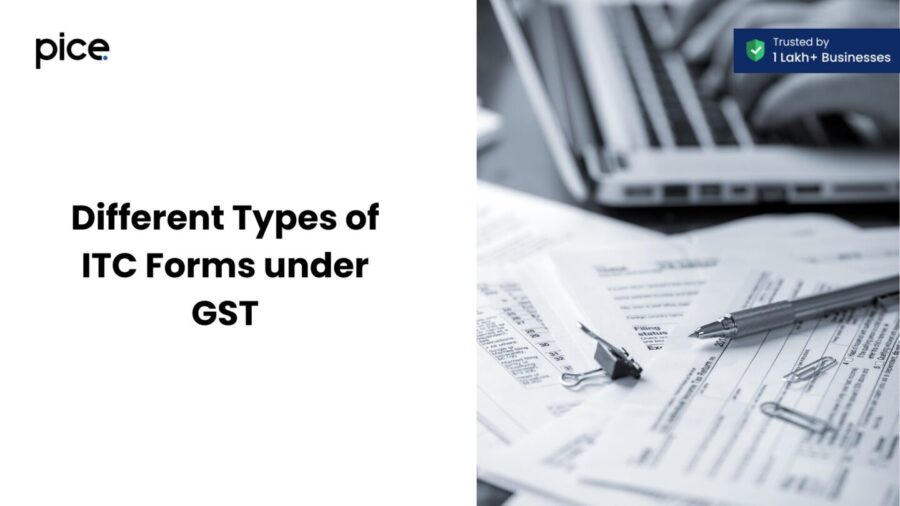Different Types of ITC Forms under GST
- 20 Sep 24
- 14 mins

Different Types of ITC Forms under GST
- Understanding Input Tax Credit (ITC) under GST
- Eligible and Ineligible Input Tax Credits
- Eligibility for Claiming Input Tax Credit under GST
- How Input Tax Credit Functions under GST
- Documentation and Forms Required for Claiming ITC under GST
- Types of Permissible Input Tax Credits
- Key Points to Consider While Filing ITC
- Step-by-Step Guide to Filing Form ITC
Key Takeaways
- ITC forms in GST are essential for claiming and managing Input Tax Credit for various business scenarios.
- ITC 03 is used for reversing ITC when opting for the composition scheme or when goods/services become exempt.
- ITC 04 tracks ITC on goods sent to job workers, ensuring accurate GST compliance.
- ITC 02 facilitates the transfer of ITC during business restructuring, such as mergers or sales.
- ITC 01 allows new GST registrants to claim ITC on existing stock and capital goods.
Understanding Input Tax Credit (ITC) under GST
Input Tax Credit (ITC) is a fundamental aspect of the Goods and Services Tax (GST) system in India. It allows businesses to reduce the tax they have paid on inputs (purchases) from their tax liability on outputs (sales). This mechanism ensures that the tax is levied only on the value addition at each stage of the supply chain, thereby avoiding the cascading effect of taxes.
To elaborate, when a business purchases goods or services, it pays GST on these purchases. This payment of tax is known as input tax. When the business makes sales, it charges GST on these sales, known as output tax. ITC allows the business to offset the input tax against the output tax, thereby reducing the overall tax liability. For instance, if a business pays INR 10,000 as GST on inputs and collects INR 15,000 as GST on outputs, it can claim an ITC of INR 10,000, making its net tax liability INR 5,000.
To claim ITC, a registered person must ensure that the goods or services are used for business purposes and that the supplier has deposited the tax with the government. Additionally, proper documentation such as invoices and GST returns must be maintained. The ITC mechanism is crucial for regular taxpayers, composition dealers, and businesses engaged in taxable supply as it optimises tax compliance and reduces the overall tax burden.
The process of claiming ITC involves several forms and declarations, which we will discuss in detail. Understanding these forms and their respective purposes is essential for businesses to effectively manage their GST compliance and claim the benefits of ITC.
Eligible and Ineligible Input Tax Credits
Eligible input tax credits are those that can be claimed under GST, provided certain conditions are met. These include GST paid on goods and services used for business purposes. Some examples of eligible ITCs are GST on raw materials, capital goods, and services directly related to the business. For instance, a manufacturer can claim ITC on GST paid for purchasing machinery, raw materials, and other inputs used in the production process.
However, not all input taxes are eligible for ITC. Ineligible input tax credits include GST paid on goods and services used for personal consumption, those that form part of exempt supplies, and certain specified items under GST law. Examples include GST on motor vehicles used for personal purposes, membership fees for clubs, and goods and services used for constructing an immovable property that is not used for further supply of goods or services.
The distinction between eligible and ineligible ITCs is critical for businesses to ensure proper tax credit utilisation. Businesses must carefully review their purchases and expenses to determine which ones qualify for ITC and maintain accurate records to support their claims. Failure to do so can result in incorrect ITC claims, leading to penalties and interest charges.
Eligibility for Claiming Input Tax Credit under GST
To claim ITC under GST, a registered person must satisfy several conditions. Firstly, the person must be registered under GST and should have received the goods or services. The supplier must have paid the tax to the government and furnished the appropriate returns. Additionally, the claimant must possess a valid tax invoice or debit note, and the goods or services must be used for business purposes.
Certain conditions disqualify a registered person from claiming ITC. For example, ITC cannot be claimed on goods and services used for personal consumption or those that form part of exempt supplies. Moreover, ITC cannot be claimed if the GST returns are not filed within the stipulated time.
💡If you want to pay your GST with Credit Card, then download Pice Business Payment App. Pice is the one stop app for all paying all your business expenses.
Regular taxpayers, composition dealers, and businesses involved in taxable supply must adhere to these eligibility criteria to claim ITC. It is crucial for businesses to maintain proper documentation and records, including tax invoices, debit notes, and payment records, to support their ITC claims. Ensuring compliance with these conditions helps businesses avoid penalties and optimize their tax liability.
How Input Tax Credit Functions under GST
The functioning of ITC under GST involves a systematic process that integrates various aspects of the tax system. When a business purchases goods or services, it pays GST on these purchases, which is recorded in the Electronic Credit Ledger. This ledger is part of the unified GST portal, where all transactions related to GST are recorded.
To claim ITC, the business must ensure that the supplier has filed the relevant GST returns and paid the tax to the government. The business then claims ITC by offsetting the input tax against its output tax liability. This process ensures that the tax is levied only on the value addition at each stage of the supply chain, thereby avoiding double taxation.
The mechanism also involves proper documentation, such as tax invoices, debit notes, and payment records. Businesses must maintain accurate records and file GST returns on time to claim ITC. Additionally, the GST law mandates that ITC can be claimed only if the goods or services are used for business purposes and not for personal consumption.
Regular taxpayers, composition dealers, and businesses engaged in taxable supply must understand the functioning of ITC to manage their tax compliance effectively. Through optimise ITC claims, businesses can reduce their overall tax liability and ensure smooth operations.
Documentation and Forms Required for Claiming ITC under GST
Claiming ITC under GST requires several forms and documents, each serving a specific purpose. These forms ensure proper documentation and compliance with GST laws. The primary forms used for claiming ITC include Form ITC 01, Form ITC 02, Form ITC 03, and Form ITC 04.
Form GST ITC 01 – ITC for New GST Registrations
Form ITC 01 is used by businesses registering under GST for the first time. It allows them to claim ITC on inputs held in stock, inputs contained in semi-finished or finished goods, and capital goods on the day immediately preceding the date of GST registration. This form is essential for new businesses to claim ITC on their existing stock and capital goods, ensuring they start their GST compliance on the right foot.
To file Form ITC 01, businesses must provide details such as the stock of goods held, the GST paid on these goods, and the invoice details. The form must be submitted within 30 days from the date of GST registration. Accurate documentation and record-keeping are crucial for successfully claiming ITC using this form.
Form GST ITC 02 – Transfer of ITC in Cases of Sale/Merger, etc.
Form ITC 02 is used when there is a transfer of business due to sale, merger, demerger, amalgamation, or transfer of business as a going concern. This form allows the transferor to transfer the ITC to the transferee. It ensures that the ITC is not lost during the business transfer and can be utilised by the new entity.
To file Form ITC 02, businesses must provide details of the transferor and transferee, the GST registration details, and the amount of ITC to be transferred. The form must be accompanied by a copy of the transfer agreement or other relevant documents. Proper documentation and compliance are essential for successfully transferring ITC using this form.
Form GST ITC-03 – Reversal of ITC
Form ITC 03 is used when a registered person opts for the composition scheme or when goods or services are used for exempt supplies. This form is used to reverse the ITC claimed earlier, ensuring that the tax credit is not misused. It helps maintain the integrity of the GST system and ensures proper tax compliance.
To file Form ITC 03, businesses must provide details of the ITC to be reversed, the reason for reversal, and the relevant invoice details. The form must be submitted within 60 days from the date of opting for the composition scheme or the date of the supply becoming exempt. Accurate documentation and record-keeping are crucial for successfully reversing ITC using this form.
ITC 04 – ITC on Goods Sent to Job Workers
Form ITC 04 is used to claim ITC on goods sent to job workers. It allows businesses to track the movement of goods sent to job workers and ensure that ITC is claimed correctly. This form is essential for businesses engaged in manufacturing and other activities that involve sending goods to job workers.
To file Form ITC 04, businesses must provide details of the goods sent to job workers, the GST paid on these goods, and the job worker's details. The form must be submitted on a quarterly basis. Proper documentation and compliance are essential for successfully claiming ITC using this form.
Types of Permissible Input Tax Credits
Permissible input tax credits under GST include GST paid on goods and services used for business purposes. These include GST on raw materials, capital goods, and services directly related to the business. For instance, a manufacturer can claim ITC on GST paid for purchasing machinery, raw materials, and other inputs used in the production process.
However, not all input taxes are eligible for ITC. Ineligible input tax credits include GST paid on goods and services used for personal consumption, those that form part of exempt supplies, and certain specified items under GST law. Examples include GST on motor vehicles used for personal purposes, membership fees for clubs, and goods and services used for constructing an immovable property that is not used for further supply of goods or services.
The distinction between eligible and ineligible ITCs is critical for businesses to ensure proper tax credit utilisation. Businesses must carefully review their purchases and expenses to determine which ones qualify for ITC and maintain accurate records to support their claims. Failure to do so can result in incorrect ITC claims, leading to penalties and interest charges.
Key Points to Consider While Filing ITC

When filing ITC, businesses must consider several key points to ensure proper compliance and maximise their tax benefits. These include maintaining accurate records of purchases and expenses, ensuring that suppliers have paid the GST to the government, and filing GST returns on time.
Proper documentation is essential for claiming ITC. Businesses must maintain tax invoices, debit notes, and payment records to support their ITC claims. These documents must be accurate and up-to-date to avoid discrepancies and penalties.
Businesses must also ensure that the goods or services are used for business purposes and not for personal consumption. ITC cannot be claimed on goods and services used for personal purposes, those that form part of exempt supplies, or certain specified items under GST law.
Timely filing of GST returns is crucial for claiming ITC. Businesses must file their GST returns on time to avoid penalties and ensure that their ITC claims are processed smoothly. Late filing can result in interest charges and penalties, reducing the overall tax benefits.
Step-by-Step Guide to Filing Form ITC
Filing Form ITC involves several steps, each requiring careful attention to detail and proper documentation. Here is a step-by-step guide to filing Form ITC:
- Gather Required Documents: Collect all necessary documents, including tax invoices, debit notes, payment records, and other supporting documents.
- Verify Supplier Compliance: Ensure that the supplier has paid the GST to the government and filed the relevant GST returns.
- Access GST Portal: Log in to the unified GST portal using your GST registration details.
- Fill Out Form ITC: Enter the required details in the appropriate ITC form (e.g., ITC 01, ITC 02, ITC 03, ITC 04). Ensure that all details are accurate and complete.
- Attach Supporting Documents: Attach the necessary supporting documents, such as tax invoices, debit notes, and payment records.
- Submit the Form: Review the form for accuracy and completeness, then submit it through the GST portal.
- Keep Records: Maintain accurate records of the submitted form and supporting documents for future reference and compliance.
By following these steps, businesses can ensure proper filing of Form ITC and optimise their ITC claims under GST. Proper documentation, timely filing, and compliance with GST regulations are essential for maximising tax benefits and ensuring smooth business operations.
 By
By 


















